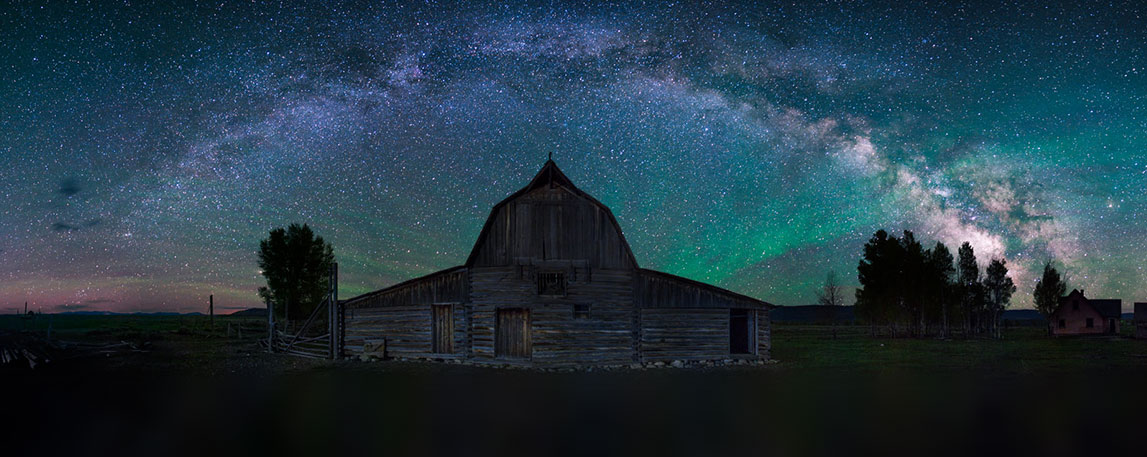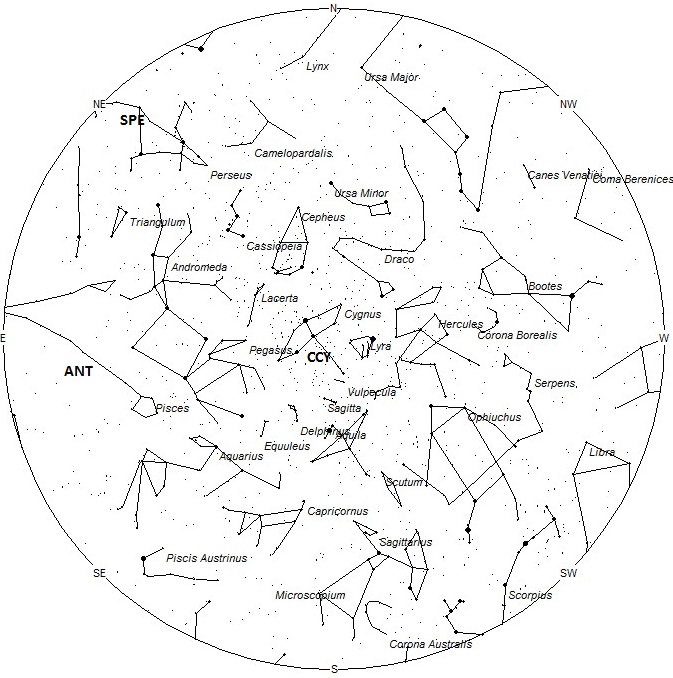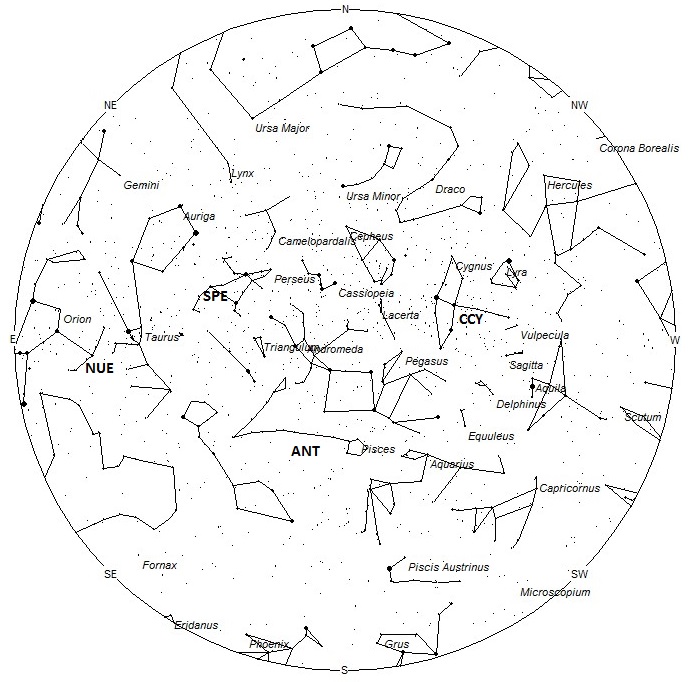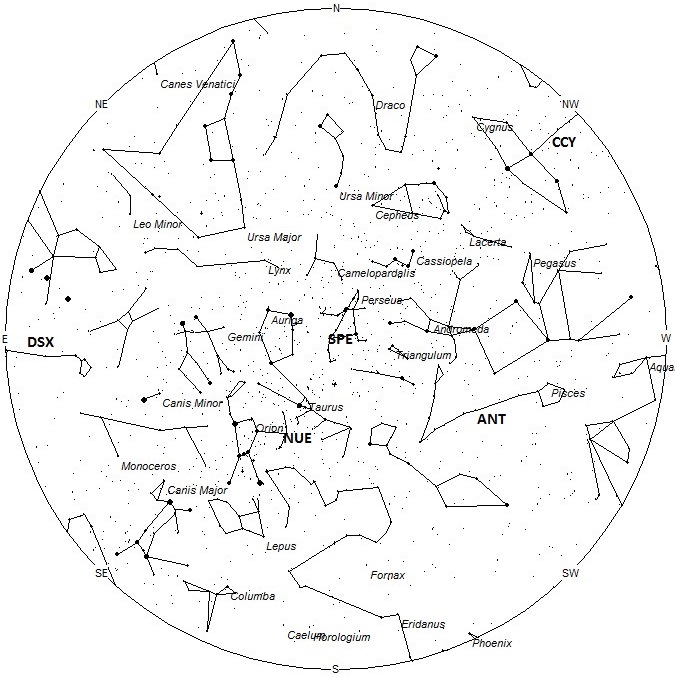
During this period the moon will reach its new phase on Wednesday September 20th. At this time the moon will be located near the sun and will be invisible at night. This weekend the waning crescent moon will rise just before dawn and will not pose any problems to those trying to view meteor activity. The estimated total hourly meteor rates for evening observers this week is near 4 for those viewing from the northern hemisphere and 3 for those located south of the equator. For morning observers the estimated total hourly rates should be near 14 as seen from mid-northern latitudes and 10 from the southern tropics. The actual rates will also depend on factors such as personal light and motion perception, local weather conditions, alertness and experience in watching meteor activity. Note that the hourly rates listed below are estimates as viewed from dark sky sites away from urban light sources. Observers viewing from urban areas will see less activity as only the brighter meteors will be visible from such locations.
The radiant (the area of the sky where meteors appear to shoot from) positions and rates listed below are exact for Saturday night/Sunday morning September 16/17. These positions do not change greatly day to day so the listed coordinates may be used during this entire period. Most star atlases (available at science stores and planetariums) will provide maps with grid lines of the celestial coordinates so that you may find out exactly where these positions are located in the sky. A planisphere or computer planetarium program is also useful in showing the sky at any time of night on any date of the year. Activity from each radiant is best seen when it is positioned highest in the sky, either due north or south along the meridian, depending on your latitude. It must be remembered that meteor activity is rarely seen at the radiant position. Rather they shoot outwards from the radiant so it is best to center your field of view so that the radiant lies at the edge and not the center. Viewing there will allow you to easily trace the path of each meteor back to the radiant (if it is a shower member) or in another direction if it is a sporadic. Meteor activity is not seen from radiants that are located far below the horizon. The positions below are listed in a west to east manner in order of right ascension (celestial longitude). The positions listed first are located further west therefore are accessible earlier in the night while those listed further down the list rise later in the night.
These sources of meteoric activity are expected to be active this week.
.
The chi Cygnids (CCY) are a new discovery due to an outburst observed on September 15, 2015. These meteors are expected to be active from September 8-17, with maximum occurring on September 13-14. The radiant currently lies at 20:08 (302) +32 which places it in southern Cygnus, 4 degrees southeast of the 4th magnitude star known as eta Cygni. Rates are expected to be less than 1 per hour no matter your location. This radiant lies highest in the sky near 22:00 (10pm LDT) . With an entry velocity of 15 km/sec., the average chi Cygnid meteor would be very slow.
The center of the large Anthelion (ANT) radiant is currently located at 00:28 (007) +04. This position lies in southern Pisces, 5 degrees southwest of the 4th magnitude star known as delta Piscium. Due to the large size of this radiant, Anthelion activity may also appear from northwestern Cetus as well as Pisces. This radiant is best placed near 0200 local daylight saving time (LDT), when it lies on the meridian and is located highest in the sky. Hourly rates at this time should be near 2 no matter your location. With an entry velocity of 30 km/sec., the average Anthelion meteor would be of medium-slow velocity.
The September Epsilon Perseids (SPE) are active from September 3 through October 3 with the peak occurring on the night of September 9/10. The radiant is currently located at 03:44 (056) +40. This position lies in southern Perseus, 3 degrees southwest of the 3rd magnitude star known as epsilon Persei. The radiant is best placed near 0500 LDT, when it lies highest above the horizon. Rates are expected to be near 1 per hour as seen from the northern hemisphere and less than 1 as seen from the southern hemisphere. With an entry velocity of 65 km/sec., most activity from this radiant would be swift.
The nu Eridanids (NUE) were co-discovered by Japanese observers using SonotoCo and Juergen Rendtel and Sirko Molau of the IMO. Activity from this long-period stream stretches from August 24 all the way to November 16. Maximum activity occurs on September 24. The radiant currently lies at 04:44 (071) +05, which places near the Taurus/Orion border, 3 degrees southwest of the 4th magnitude star known as Pi4 Orionis. This area of the sky is best seen during the last dark hour before dawn when the radiant lies highest in a dark sky. Current rates are expected to be near 1 per hour during this period no matter your location. With an entry velocity of 67 km/sec., the average meteor from this source would be of swift velocity. Some experts feel that these meteors are early members of the Orionid shower, which peaks on October 22.
The Daytime Sextantids (DSX) are not well known due to the fact that the radiant lies close to the sun and these meteors are only visible during the last couple of hours before dawn. The radiant is currently located at 09:32 (143) +03. This position lies in western Hydra, 3 degrees east of the 4th magnitude star known as theta Hydrae. This area of the sky is best placed in the sky during the last hour before dawn, when it lies highest above the horizon in a dark sky. Since the maximum is not until September 29, current rates would be most likely less than 1 per hour no matter your location. Spotting any of this activity would be a notable accomplishment. With an entry velocity of 33km/sec., most activity from this radiant would be of medium-slow speed.
As seen from the mid-northern hemisphere (45N) one would expect to see approximately 10 sporadic meteors per hour during the last hour before dawn as seen from rural observing sites. Evening rates would be near 3 per hour. As seen from the tropical southern latitudes (25S), morning rates would be near 7 per hour as seen from rural observing sites and 2 per hour during the evening hours. Locations between these two extremes would see activity between the listed figures.
The list below offers the information from above in tabular form. Rates and positions are exact for Saturday night/Sunday morning except where noted in the shower descriptions.
| SHOWER | DATE OF MAXIMUM ACTIVITY | CELESTIAL POSITION | ENTRY VELOCITY | CULMINATION | HOURLY RATE | CLASS |
| RA (RA in Deg.) DEC | Km/Sec | Local Daylight Saving Time | North-South | |||
| chi Cygnids (CCY) | Sept 13-14 | 20:08 (302) +32 | 15 | 22:00 | <1 – <1 | IV |
| Anthelions (ANT) | – | 00:28 (007) +04 | 30 | 02:00 | 2 – 2 | II |
| September Epsilon Perseids (SPE) | Sep 10 | 03:44 (056) +40 | 65 | 06:00 | 1 – <1 | II |
| nu Eridanids (NUE) | Sep 24 | 04:44 (071) +05 | 67 | 07:00 | 1 – 1 | IV |
| Daytime Sextantids (DSX) | Sep 29 | 09:32 (143) +03 | 33 | 12:00 | <1 – <1 | IV |
 American Meteor Society
American Meteor Society



in ireland, 2:30am exactly (17/9/17), saw one briefly passing just below cygnus. Funny how I just so happened to glance out the window on such a clear night since it’s usually so cloudy here! no more have been spotted since I’m afraid.
As I was riding home tonight around 8:15 in Vermilion Ohio I saw a huge beautifully clear shooting star in the South heading Southeast over the Vermilion rest area off of I-90 it was absolutely beautiful and breathtaking to see
Hi There,
We spotted on 21 sept at 9.00 pm a hugs lightball in the sky above the Netherlands and Belgium. Its been reported over 200 times from people how saw this.
Could this be one of NUE?
I am looking forward for your answer
Kind Regards,
Desiree
Desiree and All,
In order for a meteor to belong to a shower the radiant (the area of the sky where the meteor comes from) must be near or above the horizon. At that time and location the NUE radiant lies well below the horizon so it could not have been a member of this shower. Astronomers have already determined that this meteor came from the constellation of Pisces and called it a Northern Piscid. In actuality the northern Piscids are an obsolete shower as the much stronger Southern Taurid radiant lies in the same area of the sky during this time of year. So we would have called this fireball a member of the Southern Taurid shower.
Robert Lunsford